Hi all,
I'm posting this to let people know how I "may" have wrecked by Tri-Glide feature of my Trailair Pinbox - all in an effort to help you prevent the same.
My Setup:
- 2011 Heartland Landmark San Antonio
- Lippert Electronic/Hydraulic Leveling (4 point)
- Trailair Pinbox with Tri-Glide lower jaw
The Symptom:
About 3/4 the way into my last day of travel to the Branson rally this week, the RV began banging against the hitch in the truck when stopping and then tugging back when starting from a stop. Figured it had to be the Tri-Glide as this is the only item in my setup that allows any push-pull motion.
The Failure:
Upon inspection, the lower plate of the Tri-Glide was smashed up against the upper section of the Tri-Glide. That is, there was no gap anymore. The back corners of the plate had also bent downward as if they were trying to wrap around my 5th wheel hitch plate. On the top of the lower plate, on each side were deep grind marks where the upper portion was grinding hard on top of the plate.
Unhitching:
Simply stated - I could not pull the hitch handle, no matter what I tried. Until I dumped the all the air from the air suspension on my truck. First time I ever had to do this to unhitch (out of hundreds of uses).
Further Inspection:
After I got unhitched and leveled out the RV, I inspected the pinbox further. The lower plate of the Tri-Glide had now dropped down to reveal a gap above it where I could look into. I noticed a difference between the left and right sides, inside the Tri-Glide. So something had failed for sure. But why?
One "possible" explanation":
On travel days, we do not unhook the truck. I want to stabilize the RV and level it a bit if possible. My practice has been to lower the front jacks until they take a small amount of pressure off the truck. Then I drop the rear leveling jacks until the touch the ground. From there, I read the lights and the display to determine how out-of-level I may be, then gently tweak the leveling, taking care not to take too much pressure off the hitch. I am never able to fully level the coach as invariably, the terrain will not allow it when connected to the truck.
What I think may have happened, after 9 months of using this method of slightly, manually leveling when needed, is to weaken the internals of the Tri-Glide to the point where the last time it happened, it was the "straw that broke the camel's back". Then, 4 hours into driving, during a movement of the Tri-Glide, it simply failed. Then driving another couple hours with it failed, it really messed itself up by grinding and bending.
Resolution:
Lippert sent me a new Tri-Glide jaw and Terry (can't recall his username), a fellow Heartlander helped me remove the old and install the new. I'd hate to do a Tri-Glide upgrade alone! Be easier to install an assembled Trailair with Tri-Glide than to do a Tri-Glide upgrade - IMHO. The Tri-Glide weighed 118 pounds and had to be "maneuvered" to get out and then back in
Conclusion:
So, I share all of this not to only show what an idiot I may be, but to advise others who may also stabilize and slightly level their rigs when attached to the truck, to take great care to make little, to no changes in pressure and geometry to the pinbox/hitch area when doing so.
Pictures:
Below are some pictures taken with my phone during the inspection and repair phase.
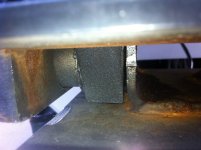
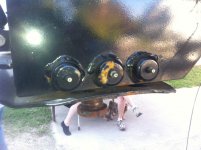
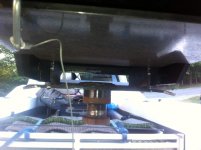
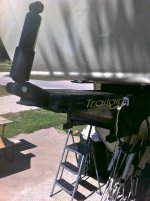
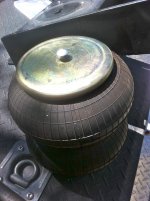
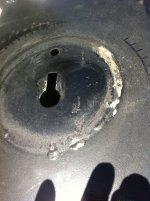
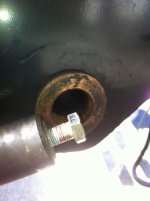
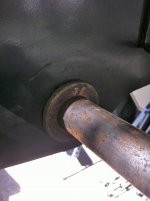
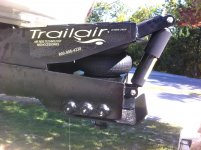
Resources:
I have attached Lippert's Tri-Glide Installation Manual. For those who have the Tri-Glide, pay attention to a couple of things.
I'm posting this to let people know how I "may" have wrecked by Tri-Glide feature of my Trailair Pinbox - all in an effort to help you prevent the same.
My Setup:
- 2011 Heartland Landmark San Antonio
- Lippert Electronic/Hydraulic Leveling (4 point)
- Trailair Pinbox with Tri-Glide lower jaw
The Symptom:
About 3/4 the way into my last day of travel to the Branson rally this week, the RV began banging against the hitch in the truck when stopping and then tugging back when starting from a stop. Figured it had to be the Tri-Glide as this is the only item in my setup that allows any push-pull motion.
The Failure:
Upon inspection, the lower plate of the Tri-Glide was smashed up against the upper section of the Tri-Glide. That is, there was no gap anymore. The back corners of the plate had also bent downward as if they were trying to wrap around my 5th wheel hitch plate. On the top of the lower plate, on each side were deep grind marks where the upper portion was grinding hard on top of the plate.
Unhitching:
Simply stated - I could not pull the hitch handle, no matter what I tried. Until I dumped the all the air from the air suspension on my truck. First time I ever had to do this to unhitch (out of hundreds of uses).
Further Inspection:
After I got unhitched and leveled out the RV, I inspected the pinbox further. The lower plate of the Tri-Glide had now dropped down to reveal a gap above it where I could look into. I noticed a difference between the left and right sides, inside the Tri-Glide. So something had failed for sure. But why?
One "possible" explanation":
On travel days, we do not unhook the truck. I want to stabilize the RV and level it a bit if possible. My practice has been to lower the front jacks until they take a small amount of pressure off the truck. Then I drop the rear leveling jacks until the touch the ground. From there, I read the lights and the display to determine how out-of-level I may be, then gently tweak the leveling, taking care not to take too much pressure off the hitch. I am never able to fully level the coach as invariably, the terrain will not allow it when connected to the truck.
What I think may have happened, after 9 months of using this method of slightly, manually leveling when needed, is to weaken the internals of the Tri-Glide to the point where the last time it happened, it was the "straw that broke the camel's back". Then, 4 hours into driving, during a movement of the Tri-Glide, it simply failed. Then driving another couple hours with it failed, it really messed itself up by grinding and bending.
Resolution:
Lippert sent me a new Tri-Glide jaw and Terry (can't recall his username), a fellow Heartlander helped me remove the old and install the new. I'd hate to do a Tri-Glide upgrade alone! Be easier to install an assembled Trailair with Tri-Glide than to do a Tri-Glide upgrade - IMHO. The Tri-Glide weighed 118 pounds and had to be "maneuvered" to get out and then back in
Conclusion:
So, I share all of this not to only show what an idiot I may be, but to advise others who may also stabilize and slightly level their rigs when attached to the truck, to take great care to make little, to no changes in pressure and geometry to the pinbox/hitch area when doing so.
Pictures:
Below are some pictures taken with my phone during the inspection and repair phase.









Resources:
I have attached Lippert's Tri-Glide Installation Manual. For those who have the Tri-Glide, pay attention to a couple of things.
- Bolt Torque:
There is a 9/16" hex headed bolt on each side of the Tri-Glide that hold the large diameter long "Pivot Pin" in place at the rear of the jaw. The required torque of these bolts per Lippert is 90 to 110 foot pounds. I also noticed a bit of red Loctite threadlocker on the rearmost threads of these bolts. I see nothing about its use in the manual - but it's probably a good idea. Mine were not very tight and I spoke to Mickey today and he told me he had one that was really backed out!
The bolts/nuts on the top and bottom of the shock mounts are also 9/16" and require the same 90-110 foot pounds of torque. - Lubrication:
There are 9 grease zerks on the Tri-Glide. Three each on each side of the Tri-Glide are clearly visible. But there are 3 more that are rather hidden. They are above the lower plate and are accessible from behind the pinbox.
